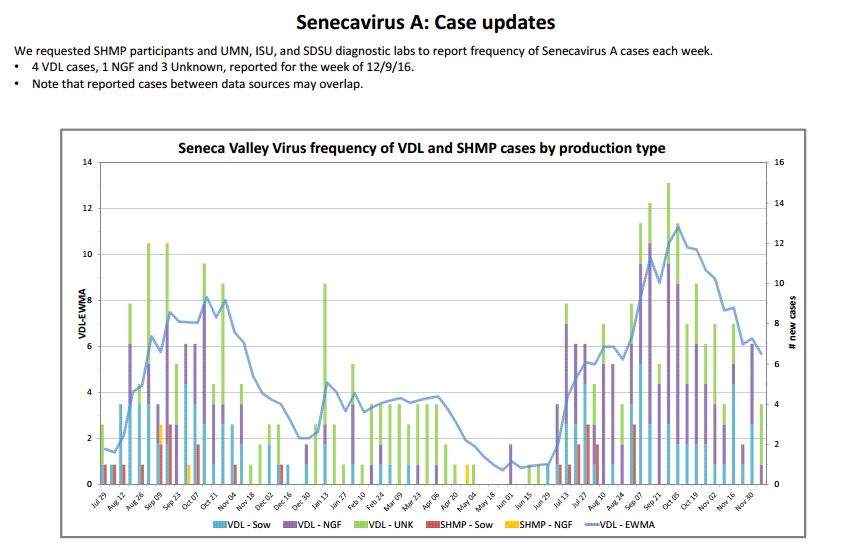Stay Informed with SHIC
Are you getting the latest disease information from SHIC? If not, be sure to subscribe now to SHIC’s newsletter. It’s the best way to make sure you don’t miss resources such as the full series of webinars reporting on Seneca Valley Virus (SVV) research funded by the SHIC and other sources (including length of shedding, effective disinfection and epidemiological investigations). It’s also where you learn about first-hand case studies of herd closure to eliminate the virus and the latest on USDA guidance for investigation and responses. Fact sheets on SVV and other Swine Disease Matrix viruses are also found at SHIC’s website.
Seneca Valley Virus Information and Resources
Although SVV may not be at its highest peak from early fall, in the recent data from the Swine Health Monitoring Project (SHMP) it’s still very much out there and poses a big risk to farms and packing plants alike. However, the bigger risk may be assuming that SVV is what you are actually seeing. The reality could be far worse, which is why it’s critical that you always contact your state or federal animal health official when you see clinical signs of vesicular disease to ensure it’s not foot-and-mouth disease (FMD), which is in the same family (Picornaviradae).

The SHMP, developed in 2012, continues to monitor the incidence of diseases such as PRRS and SVV. Today, it represents 29 systems from across the country and has approximately 1,000 sow herds and 2.6 million sows. With support from the Swine Health Information Center, one of its objectives is to help monitor the emergence and movement of swine diseases across the U.S. Beginning in 2015, the SHMP started tracking the cases of Senecavirus A (SVV) through reporting from the project’s participants and the Iowa State University, University of Minnesota and South Dakota State University swine veterinary diagnostic labs.
These data include reports of positive accessions into the three participating veterinary diagnostic labs. They don’t indicate if a positive accession is a new case or a previously identified case that is continuing to monitor. However, there is concern that, after a continued but relatively low incidence during the winter months, people may become complacent about monitoring and reporting of SVV or SVV-like symptoms.
Follow Proper Protocols, Know the Plan Cases of pigs or sows with vesicles continue to show up at packing plants. U.S. packing plants must continue to be able to operate normally with the number of pigs and sows being processed every day. Vesicular lesions in pigs or sows ready for marketing should be investigated, and if possible, the lesions should be allowed to resolve before shipping. If that isn’t possible, communication between the packing plant, state animal health official and USDA is essential if pigs or sows are to be shipped without significant disruption to the normal operations of both the plant and the producer involved.
The USDA has issued a guidance document for its field staff that provides a good description of their plan to properly handle potential FAD investigations where information suggests that SVV may be suspected. This guidance tells those doing the investigations that duplicate samples may be taken when appropriate, sending one to a National Animal Health Laboratory Network Veterinary Diagnostic Lab (NAHLN VDL) and another to the Foreign Animal Disease Diagnostic Laboratory on Plum Island, New York. The federal and state animal health officials may use the clinical presentation and the NAHLN diagnostic test result to make initial decisions about movement of the pigs. The USDA lab on Plum Island, however, is the official lab that can confirm a negative FMD test.
The mission of the Swine Health Information Center is to protect and enhance the health of the United States swine herd through coordinated global disease monitoring, targeted research investments that minimize the impact of future disease threats, and analysis of swine health data. For more information, visit http://www.swinehealth.org or contact Dr. Sundberg at psundberg@swinehealth.org.